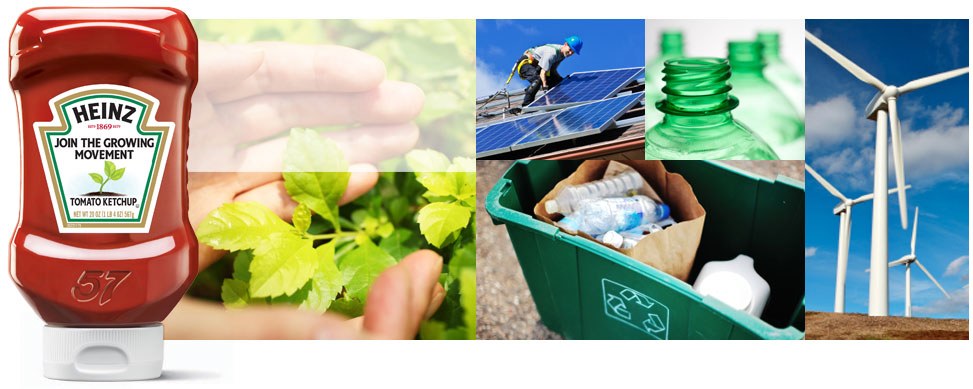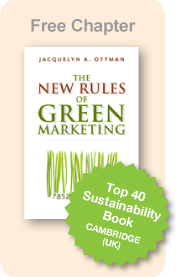Jacquie Ottman's
Green Marketing Blog
Demystifying Biobased Products Keys to Marketing Success
December 06, 2012 by Jacquie Ottman & Mark Eisen

Communicating the benefits of “biobased” content, the world’s newest ecological marketing term, is often tricky. Biobased represents all of green marketing’s traditional challenges — including greenwash — but has additional, unique challenges all its own. Happily, strategies and a credible third party label now exist.
Opportunities For Biobased Products and Packaging
There are many reasons for a business to use biobased content instead of traditional petroleum-based ingredients in their products, including: it helps grow the farm economy, promotes energy independence, and helps manage carbon impacts, providing a useful hedge against potential future carbon taxes. Finally, biobased agricultural and other renewable material can mitigate petroleum’s wild price fluctuations, supply disruptions and geopolitics.
From an image and marketing perspective, a shift to biobased content can enhance reputation with stakeholders, including risk adverse investors. It can boost sales in the B2B and B2C sectors, as well as support and enhance many types of ‘green’ claims. Let’s look at these in more depth.
Selling opportunities are growing in the federal, commercial, and consumer markets. In the U.S., for instance, the federal sector will benefit from an Obama executive order signed in March 2012 to double the amount of biobased purchases.
Initial market research suggests consumer willingness to purchase biobased products and packages. Research commissioned by Genencor in 2011 suggests 40% of Americans are ‘aware of’ the term biobased and 77% will ‘definitely’ or ‘likely’ buy comparable biobased products.
In the consumer sector, biobased content can halo a brand. Coke’s new partly sugarcane-based PET ‘PlantBottle’ (with ‘up to’ 30% bioplastic), reinforces the brand positioning of Coke’s health-oriented Dasani bottled water and Odwalla juice brands. PlantBottle is now being licensed from Coke by H.J. Heinz for its iconic ketchup brand. An image of the bottle is below.

In 2010, 83% of U.S. adults identify with ‘green’ values, with various segments expressing their own reasons for likely interest in biobased. For instance, the LOHAS (Lifestyles of Health and Sustainability) segment represents the deep green consumers who take a holistic approach to all things sustainable and green; Naturalites look for organic food, natural personal care, cleaning and pet foods; Conventionals conserve natural resources; and status conscious Drifters who like to be seen carrying cloth shopping bags and driving a Toyota Prius. (Source: The Natural Marketing Institute).
Together, these consumers fuel a $290 billion U.S. market for natural products, renewable energy and more benign household products. Well-known brands that actively incorporate biobased content include Ford, Seventh Generation, Stonyfield Farm, and Procter & Gamble’s Gillette ProFusion and Pantene brands.
Marketing Challenges of Biobased
1. Unfamiliarity. Consumers don’t know the meaning of ‘biobased’. The term is not in the dictionary and is limited to scientific, engineering and B2B usages. USDA, which introduced a “USDA Certified Biobased Label” in early 2011, defines biobased as made from agricultural materials, forestry and marine based sources; so, even a well-informed consumer needs to learn that biobased products come from more than soy and corn.
2. Risk of Greenwash. Because biobased is unfamiliar but sounds ‘green’, consumers can infer such environmental benefits as “natural”, “renewable” and “biodegradable” which may or may not be the case depending upon the product. Benefits that are too easily and often incorrectly implied or overstated increase reputation risk.
Green marketing lessons of the past still apply. As Mobil learned the hard way, in the early 1990’s, their Hefty trash bags which were marketed as ‘photodegradable’ (although not called biobased) were pulled from the market after seven state attorneys general sued saying that the bags would disintegrate (i.e., break down into small fragments under the influence of heat and/or oxygen) but not degrade in landfills for which they were intended and advertised. (See the recently revised FTC Green Guides for further detail.)
3. Science. The ASTM D6866 scientific test standard upon which the USDA Certified Biobased label is based, helps define ‘biobased’ and accurately measure content. Even with this credibility, results present communication challenges. Because the test measures biobased content as a percent of total carbon content, minerals and water are excluded. This can make comparisons difficult between products that contain minerals and water versus those with only biobased ingredients.
4. Red flags. Despite its many benefits, biobased content raises some red flags among some segments of consumers. For instance, some biobased products could compromise performance; a case in point, the first Sun Chips ‘compostable’ bag made from corn-based PLA bioplastic had to be withdrawn because it was noisy; PLA manufacturer Natureworks quickly reformulated.
Also, some consumers take issue with biobased materials made from genetically altered crops (as is the case with most corn and soy grown in the U.S.), or are concerned about the effect agriculturally-based content may have on food prices.
Some may also question the sustainability of the harvesting practices. Finally, some consumers are concerned that biobased ingredients are imported rather than domestic, thus representing carbon impacts associated with transporting the materials from distant shores, or steal business from domestic farmers.
5. Confusion and misinformation. Still, many consumers — and even product marketers — mix up the terms ‘bio-based’ and ‘bio-degradable’. Both these properties are absolutely independent. Biobased refers to the origin of a material and biodegradable refers to the end-of-life. Biobased does not mean a material is biodegradable and vice-versa.
Success Strategies for Marketing Biobased Products and Packaging
To market biobased products and packaging with impact, relevance and credibility consider the following strategies:
1. Promote uniformity to let consumers compare biobased content by adhering to ASTM D6866. Disclose the source of the biobased content and dsitinguish between content that applies to product and package. Understand implications of grammatical constructions of ‘made with’, ‘made from’ and ‘made of’.
2. Follow FTC Green Guides (in the U.S.) and other applicable country guidelines when making environmental marketing claims of or related to biobased content. The recently updated FTC Green Guides provides specific guidance for such terms that biobased products can support such as ‘biodegradable’, ‘compostable’, and ‘renewable’.
Despite obvious consumer associations of biobased as ‘ecofriendly’, avoid what FTC describes as ‘generalized environmental benefit claims’. Avoid images of ‘planets, babies and daisies’ that could imply the product is greener or contain more biobased content than in fact.
Make sure to portray environmental benefits from a total life cycle perspective.
3. Support claims with the USDA Certified Biobased label and other applicable biobased certifications to underscore credibility. Educate consumers on the meaning of ‘biobased’ and the underlying basis for the label.
4. Consider additional complementary sustainability-related certifications as appropriate. For instance, many products qualify for BPI’s Compostable, USDA Organic, U.S. EPA’s Design for Environment, and the independent Green Seal certification labels. The same is true for certification schemes in a number of other countries.
5. Carefully research and address consumer ‘red flag’ concerns. Reassure about performance and specify product applications.
Jacquelyn Ottman and Mark Eisen are colleagues at New York City-basedJ. Ottman Consulting, Inc., expert advisors to industry and government for strategic green marketing. They advised the U. S. Department of Agriculture on the launch of the USDA Certified Biobased label during 2011 and are nowworking with labelerson capturing the value of their participation in the program.
Jacquie Ottman is the author of The New Rules of Green Marketing: Strategies, Tools and Inspiration for Sustainable Branding (Greenleaf Publishing U.K., 2011). Mark Eisen is the former environmental marketing director at The Home Depot.
Additional Blog Posts on this Topic:
- USDA Certification Raises Bar for Biobased
- The Rise of the Biobased Economy - and Why Brand Owners Need to Develop a Strategy in 2012
Subscribe to Jacquie Ottman’s Green Marketing Blog. Link Here
This post was originally published in Bioplastics Magazine, May/June 2012



 ShareThis
ShareThis

